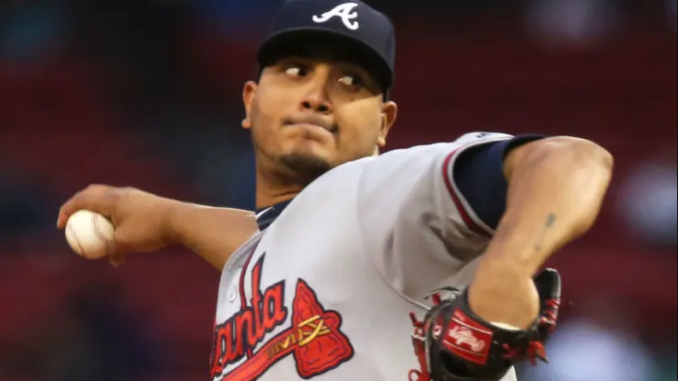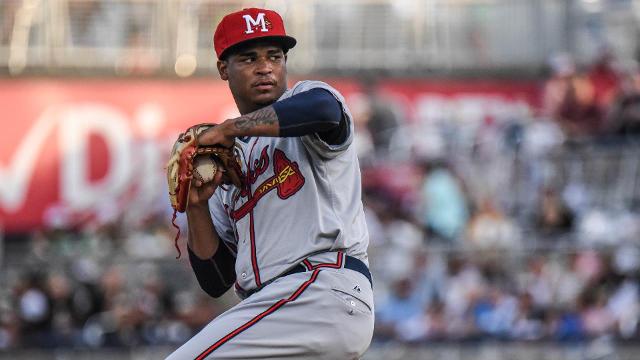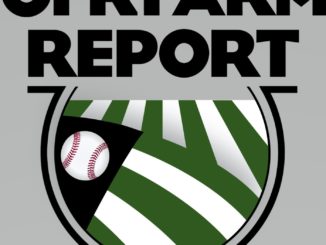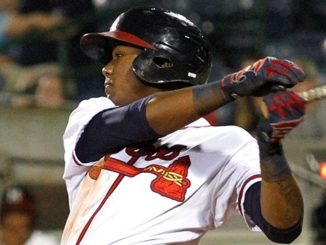
In a surprise transaction on Monday night, the Braves designated right-hander Mike Foltynewicz for assignment following a disastrous first start of the season against the Tampa Bay Rays. Foltynewicz went only 3.1 innings and allowed 6 earned runs, throwing 70 pitches, only 38 for strikes. Most concerning was the dip in the velocity of his four-seam fastball, which averaged only 90.9 miles per hour, 4 mph off the 94.9 average last season and almost 8 mph off his career velocity average. This same drop in velocity was seen in his exhibition start against Miami last week.
Last week, Foltynewicz blamed the velocity loss on wet mound conditions and a slow radar gun, conditions that didn’t seem to effect the Marlins pitchers in that game or the other Atlanta pitchers that made appearances afterward.
It would be irresponsible to speculate on the circumstances around Foltynewicz’s difficulties or the organization’s rationale behind their abrupt dismissal of a pitcher that was an All-Star just two seasons ago, so instead this post will focus on the options to replace him.
The Veterans
Veteran starters were brought in this offseason to shore up the rotation after presumed 1/2 starter Mike Soroka and Max Fried, but those plans, as so many 2020 plans, have gone horribly awry. Cole Hamels has not thrown to a live batter in this calendar year and was placed on the 45-day injured list before the season; the earliest he would be available is early September. Felix Hernandez was brought in as well to compete for the fifth starters spot, but he opted out of returning to pitch due to the COVID-19 crisis.
Josh Tomlin
Tomlin was acquired late in spring training in 2019 and pitched well out of the Atlanta bullpen, making one spot start in the last week of the season to help set up the playoff rotation. When Kyle Wright was delayed from reporting to summer camp by having to quarantine for 14 days after being exposed to a COVID-19 positive individual, Tomlin was stretched out to possibly be the fifth starter if Wright was unable to go. All this would seem to make him the favorite to be the most likely option.
Tomlin does have a long history of starting while with the Cleveland organization. Tomlin is a 35-year-old, 11-year major league veteran, so presumably having to switch roles like this won’t shake him. Perhaps most importantly, Tomlin throws strikes and allows his defense to get outs for him, a style of pitching favored by Braves coaches.
That said, Tomlin isn’t Mike Soroka and he won’t have that same kind of success. Tomlin works primarily off a 87 mph cutter, but to turn over a line-up multiple times he will have to incorporate his fastball, curve, and change-up more to keep hitters off-balance. Those pitches are not particularly high quality, and can get hit hard. If Tomlin is the choice, it would likely not be for very long.
Jhoulys Chacin
Chacin was picked up by the Braves just last week after being released by the Minnesota Twins, who had him camp on a minor league deal. It was not that long ago that Chacin was a key piece of the Milwaukee Brewers rotation; in fact, he was their Opening Day starter in 2019 after throwing 192.2 innings with a 3.50 ERA in 2018, helping them to an NL Central division championship. Last season was a disaster however, and Chacin pitched to a 6.07 as a starter for first Milwaukee, then Boston to finish out the year.
The reason for this was his fastball just became much too easy to hit. Opposing batters hit .381 against his four-seam and two-seam fastball, and out of 357 swings against his fastball hitters only missed it 51 times. The Braves likely would not have picked Chacin up if they thought the cause was hopeless however, and Chacin’s first outing of 2020 was a successful one, throwing 3.2 shutout relief innings against the Mets on Sunday. Of note is that Chacin essentially abandoned the four-seam fastball in that outing, only throwing 1 in his 54 pitches. Chacin relied heavily on his slider, sinker, and change-up.
If this sounds familiar, it should. The Braves worked similar magic with Anibal Sanchez in 2018 by radically changing his pitching mix, having him all but abandon his two-seam fastball and slider in favor of his cutter and change-up.
Touki Toussaint
It feels a little odd listing Toussaint with the veterans, but this is his third major league season, though his has never spent an entire season in Atlanta and only has 73.1 major league innings under his belt. Toussaint was #2 on the OFR Prospect List when he accumulated enough innings to lose rookie status early in 2019. At only 24 years old, Toussaint is still the same essential pitcher he was when he debuted in 2017. He has a blistering fastball/curveball/split-change combo that is among the most impressive of all the young Braves hurlers.
What he hasn’t demonstrated for a long string of performances however is the necessary command to get the most out of his pitches. With a number of other pitching prospects ready to get a chance for rotation spots, Toussaint may be running out of chances to secure a spot as a starter.

The Rookies
Bryse Wilson
Wilson has five big-league starts under his belt, but his best has been his first, 5 innings of shut-out ball at Pittsburgh in 2018. His other 4 starts happened in 2019, and the team seemed to want to give a rotation spot to him but instead signed free agent Dallas Keuchel to fill the spot. Expected to challenge for the fifth starter spot this spring, Wilson instead was among one of the first cuts.
Wilson’s minor league performances have been impeccable. A 4th-round pick in 2016, Wilson has dominated at all levels his last three full seasons, including zooming up four levels in 2018. In 2019, when he wasn’t in Atlanta, he was winning the International League ERA title for Gwinnett.
For all of that however, he has not been able to translate that success to the majors. One of Wilson’s calling cards in the minors has been his keen control, but in the majors he has been prone to nibbling. He also has thrown his four-seam fastball nearly two-thirds of the time, which has proven to be far too predictable for major league hitters, but he hasn’t shown confidence his change-up, curve, or slider. Of the three, the change-up is his most effective secondary pitch. With only 27 major league innings under his belt, it could be reasonable that simply a change of pitch selection could help. Personally, I’d like to see him paired with Alex Jackson, a catcher who is very familiar with Wilson, and see if that could make a difference.
Tucker Davidson
From humble beginnings as a 19th-round draft pick out of a Texas JUCO, Davidson was just rated the #8 prospect on the latest OFR prospect list. This is in part due to an his impressive showings in both spring and summer camp this year. This of course follows up a splendid 2019 campaign that saw him climb to AAA after pitching to a 2.03 ERA with AA Mississippi, winning the Southern League ERA title.
In camp however, the team mostly seemed to be looking at Davidson as a relief option, so there is a question as to if he is properly stretched out for starting duties. He has a strong three-pitch mix that includes a mid-90s fastball and a plus change, but can still run into bouts of wildness.
Patrick Weigel
Weigel had an impressive spring training coming off his first full season since undergoing UCL surgery. The big right-hander showed most of the usual command issues for a player coming back, but he was holding AAA opponents to a .164/.260/.302 batting line against him after July 1.
The question now seems to be if the Braves are even still looking at Weigel as a potential starter candidate. Weigel only made one start after mid-July, and he performed well out of the bullpen, a role that he also pitched well out of in college. That said, Weigel has the body and repertoire of a starter — fastball/curve/slider/change. At the very least, Weigel could be a good option if the Braves elect to go with an “opener” strategy, where Weigel would only be expected to turn the line-up over once or twice.

The Long Shots
Jasseel De La Cruz
De La Cruz climbed up the organizational ladder and up prospect lists in 2019 thanks to having a full season of good health and adding separation between his fastball and an improving change-up that establishes him as a starting rotation candidate.
That said, his highest level is a half-season experience in AA. He acquitted himself well in spring and summer camps however, and it wouldn’t be surprising to see him get his feet wet for Atlanta before the end of this season. It just seems unlikely that he would get that opportunity in the rotation, other than perhaps a spot start.
Ian Anderson
The top pitching prospect in the organization, Anderson would probably be given a long look in normal circumstances, but this season is far from normal. It seems unlikely that the Braves would Anderson to start accumulating service time at this point with so many other rotation options. Anderson did not pitch in any of the big league intrasquad games (unlike Wilson, Davidson, and Weigel), and never seemed like a candidate to make the team. Anderson would also be hampered by not currently being on the 40-man roster, unlike all of the other pitchers on this list.
That said, if Anderson is healthy and pitching well at the team’s Alternate Training Site, it’s not outside the realm of possibility that Anderson is tapped for a spot. After all, this is a team that isn’t afraid of bold moves.
Huascar Ynoa
The youngest player on the team’s 40-man roster, Ynoa was yo-yo’d between starting and relieving for most of 2019, probably to his detriment. He has looked very strong this spring and in his brief appearances this summer however, and likely will be pitching for Atlanta at some point this spring. At this point however, it seems more likely he would be a reliever in 2020, barring the use of the opener strategy.




Leave a Reply